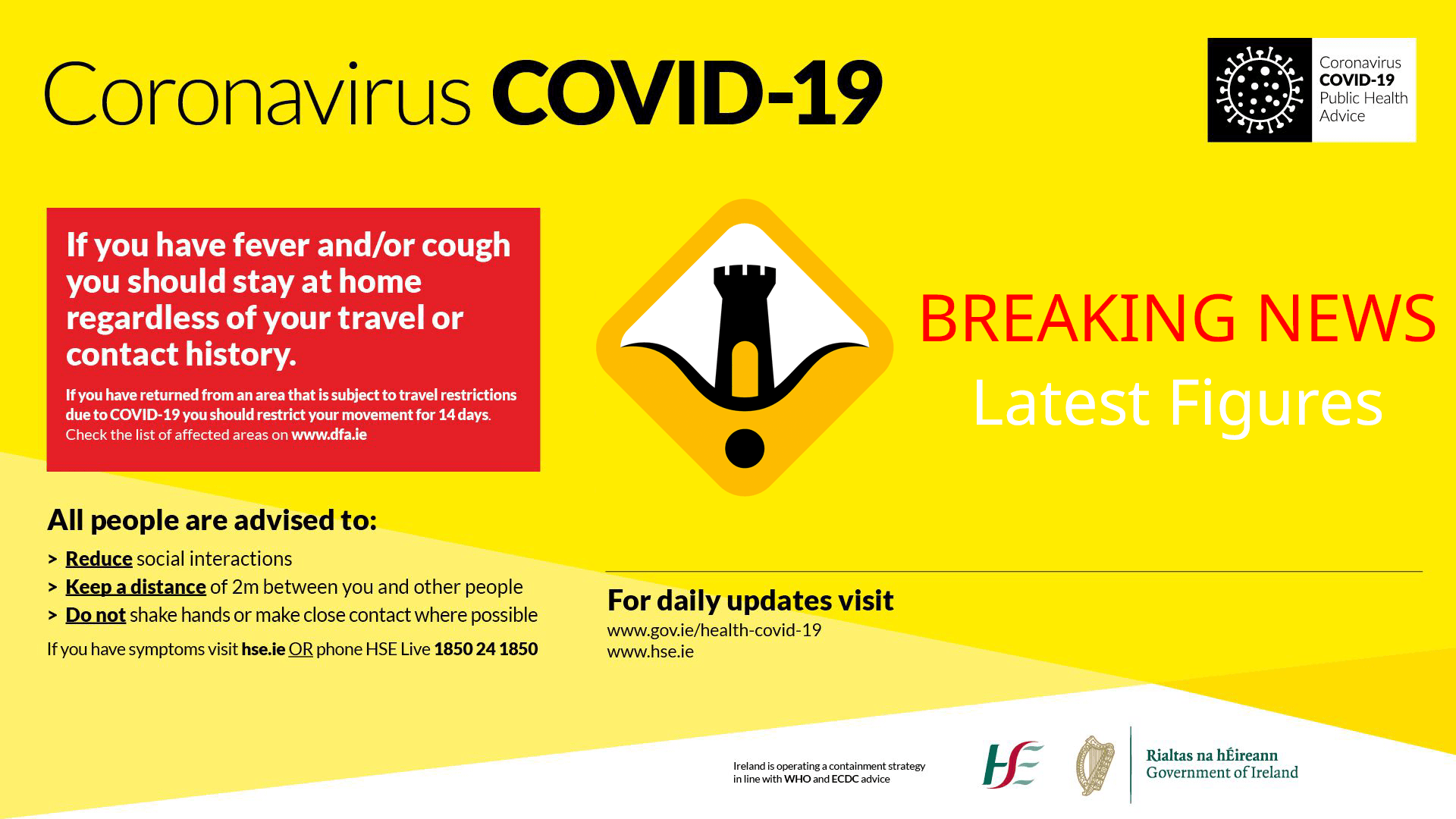Help support Cork Safety Alerts by becoming a ‘Supporter’ and donating a small amount each month to help with the running of our website, server and organisation! Click here to become a CSA Supporter.
A total of 500 newly confirmed cases of COVID-19 in Ireland today, bringing the total number to 6574 in the Republic of Ireland. 28 more deaths are also being reported today.
Statement from the National Public Health Emergency Team will follow shortly:
The Health Protection Surveillance Centre has today been informed that 28 people diagnosed with COVID-19 in Ireland have died.
· 22 deaths located in the east, 2 in the north west, 2 in the south and 2 in the west.
· the people included 15 females and 13 males
· the median age of today’s reported deaths is 84
· 19 people were reported as having underlying health conditions
There have now been 263 COVID-19 related deaths in Ireland.
The Health Protection Surveillance Centre has been informed of 500 new confirmed cases of COVID-19 in Ireland, as at 1pm, Thursday 9 April.
There are now 6,574 confirmed cases of COVID-19 in Ireland.
The HSE is now working to identify any contacts the patients may have had to provide them with information and advice to prevent further spread.
Today’s data from the HPSC, as of midnight, Tuesday 7 April (6,444 cases), reveals:
· 45% are male and 53% are female, with 317 clusters involving 1,391 cases
· the median age of confirmed cases is 48 years
· 1,521cases (24%) have been hospitalised
· Of those hospitalised, 230 cases have been admitted to ICU
· 1,765 cases are associated with healthcare workers
· Dublin has the highest number of cases at 3557, (55% of all cases) followed by Cork with 472 cases (7%)
· Of those for whom transmission status is known: community transmission accounts for 66%, close contact accounts for 24%, travel abroad accounts for 9%
The National Public Health Emergency Team’s modelling data has revealed that Ireland’s effort to date has greatly reduced the transmission of the virus.
· The growth rate has reduced from 33% daily in the early weeks of this outbreak, to 9% this week.
· The number of people, on average, that someone with COVID 19 is likely to infect was high at the beginning of the outbreak at 4.5. We now see this ‘R’ (reproduction) number reduced very significantly.
Professor Philip Nolan, Chair of the NPHET Irish Epidemiological Modelling Advisory Group (IEMAG) said; “When an R number increases by even a fraction above 1, the number of new cases per day will rise, slowly but inexorably.
“We are at a very delicate and critical point in our response to this pandemic.”
Dr. Tony Holohan, Chief Medical Officer, Department of Health, said; “The virus is still sustaining itself in our community. If we do not stay at home and practice physical distancing then we are not stopping the spread.
“It is crucial that each one of us take seriously the risks this virus poses, follows the guidelines and limit the opportunity for this virus to spread.
“We must follow the public health advice as closely as we possibly can so that we can limit the spread of the virus.
“Stay at home, practice physical distancing, practice hand hygiene, protect eachother.”
Dr. Colm Henry, Chief Clinical Officer, HSE said; “I would like to acknowledge the enormous efforts of healthcare workers caring for patients in hospitals and the community. The best way people can show support for them is by staying at home and observing the guidelines. This keeps everyone safe.”
Notes:
Research conducted on behalf of the Department of Health shows that the perceived risk of contracting coronavirus has fallen sharply, from 43% on 26th March to 32% currently.
The nationally representative online survey of 1,270 adults conducted today, which is conducted twice weekly, reveals:
- Levels of satisfaction with the amount of information from the Government or
state agencies remains extremely high at 87% - Hoarding behaviour has fallen back to 15% of adults: the level recorded at the start of the crisis on 2nd March.
- The percentage behaving safely continues to rise for behaviours such as washing hands (95%) and using sanitizer (81%), but has fallen for sitting apart from others (63%) possibly reflecting more time spent at home.
- Large majorities intend continuing with certain behaviours after coronavirus, including washing hands (93%), coughing into elbow (77%) and using sanitizer (59%).
- The proportion who feel that the worst of the coronavirus crisis is still ahead of us has fallen sharply from 85% on 16th March to 62% today.
Want to get €5, absolutely free? Sign up to the ‘Smart’ Debit Card – Curve today, and earn a fiver on us! Find out more here.

